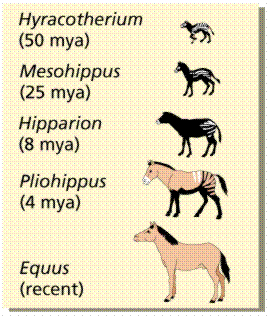Darwin’s Five Observations
- More young are produced than survive

- Individuals vary in their characteristics
- Some characteristics are better than others
- These characteristics are inheritable
- Long periods of time are available
Darwin’s Two Major Points
- Many species of organisms presently inhabiting the earth are descendants of ancestral species that were different from modern species
- The mechanism he proposed for this was natural selection
Results of Natural Selection
- Evolutionary adaptation: an accumulation of inherited characteristics that enhance an organisms ability to survive and reproduce in its environment
- Evolution: the change over time in the genetic composition of a population
Definitions
- Taxonomy: The branch of biology concerned with naming and classifying organisms
- Classifying life: species > genus> family> order> class> phylum> kingdom> domain
- Fossils: The remains or traces of organisms
- Sedimentary rock: Formed from sand and mud that settles in seas, lakes, and marshes
- Paleontology: The study of fossils
- Catastrophism: Each boundary between strata represents a catastrophe. Opposes idea of gradual evolution
- Gradualism: The idea that profound change can take place through the cumulative effect of a slow but continuous process
- Uniformitarianism: The same geological processes are operating today as they did in the past
- Population: The smallest unit that can evolve
The Origin of Species
Descent with modification: As descendants of ancestral organisms spilled into various habitats over millions of years, they accumulated diverse modification or adaptations that fit them into specific ways of life
Natural selection
- Natural selection is the differential success in reproduction among individuals that vary in their heritable traits.
- Over time, natural selection can increase the adaptation of organisms to their environment
- If an environment changes, natural selection may result in adaptation to the new environment
- Can amplify or diminish only heritable traits
- Natural selection can distinguish between acquired traits and inherited traits
